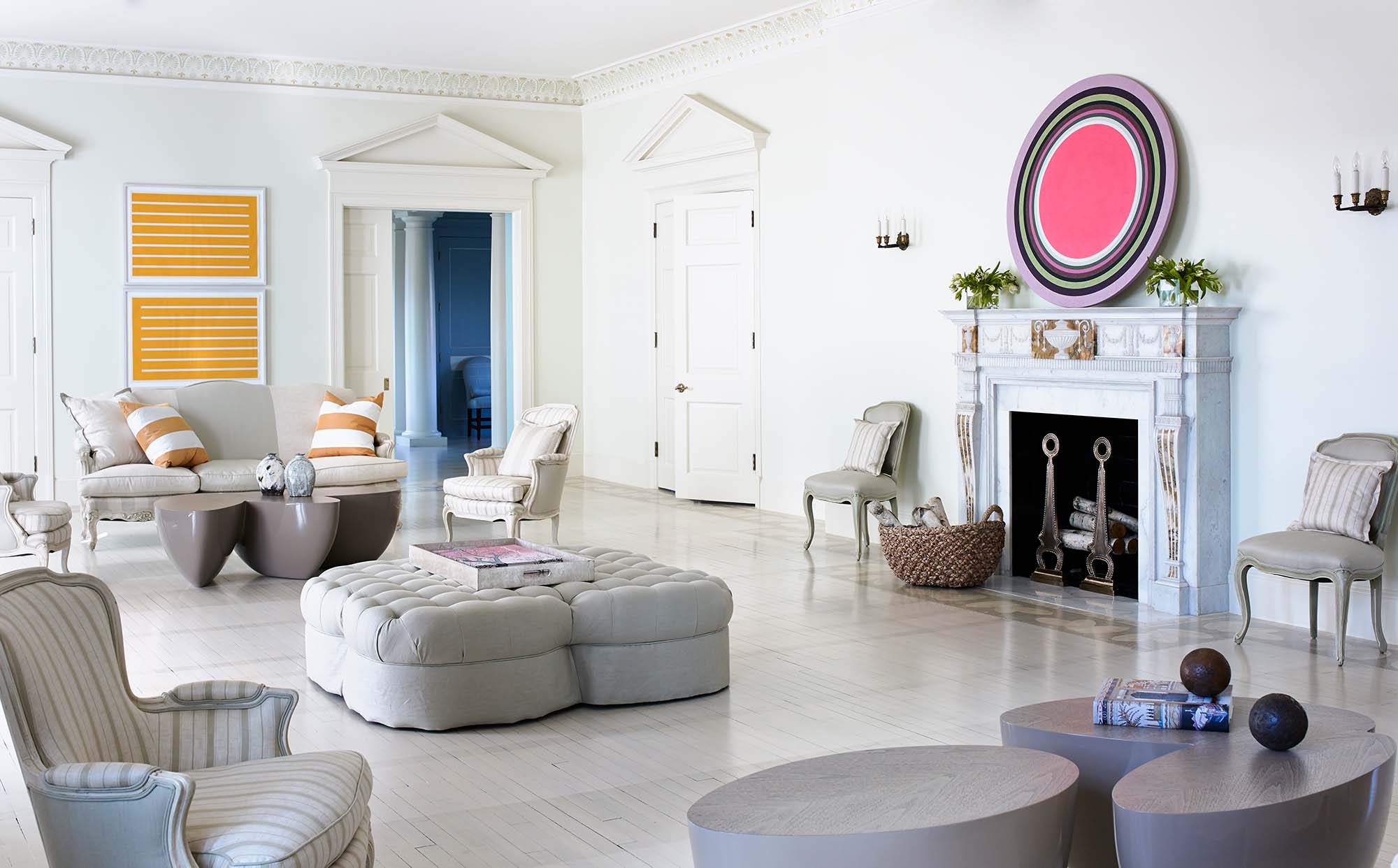- © 2025 Annapolis Home Magazine
- All Rights Reserved
By Kymberly Taylor

While gazing upon the formal living room of this 1920s home in Bethesda with Doric columns, settees once owned by Valentino, and museum-quality art, it is hard to believe that the family has four dogs that roam freely throughout the house, jumping up and lounging upon furniture. But can “metropolitan elegance” and “canine-casual” truly co-exist?
Interior designer Mary Douglas Drysdale says yes, with the help of luxury performance fabrics, of course. “It can be practical. It can be casual. It can be beautiful.” In fact, this is how the Europeans design, dissolving barriers between art and architecture, casual and informal, inside and out, she explains. “In Europe, there are no barriers between architecture and interior design,” says Drysdale, who studied art and architecture in the United States and extensively in Paris. As a child, she was steeped in the neo-classical traditions of the University of Virginia (where her father attended law school) and Monticello, where she learned that architecture was much more than beauty, sensing within its proportions a kind of sacred order.
With the history of art and architecture in mind, she draws from a varied spectrum, adding architectural details to an interior and building a room out from there. For example, the light blue-hued family room is harmonious. To this spacious rectangle with 12’ ceilings, Drysdale added Doric columns and panels in the 1920s vernacular. Elongated diamonds complete its neo-classical mood. Arranged in a geometric square, the custom blue rugs are compelling forms, especially when contrasted with the round white table. To make this room casual and livable, she worked with the owners, talking far into the night about placing the right columns in the right location, about texture, degrees, and intensities of color, and even spilling red wine on light performance fabrics to test their durability.
“My decorative painter whisked a darker shade here and there; it is a subtle gesture you may not see initially, but as you get closer, you see there are two blues there. The walls will engage you because there is more there than flat paint,” she explains.
Many people think her methods are complex, but Drysdale disagrees. “There is no magic. Each project has three things: architectural details, art, and décor.
“I create true-to-the-period architectural interiors but make them feel up to the moment and alive… with an unexpected piece of furniture, color, and modern art, painting a floor instead of putting down the usual oriental rug.”
This is evident in the living room, with its original gold-engraved fireplace. Initially, the space was large yet plain. Drysdale added pediments above the doors, identical false doors with pediments, and crown molding hand-painted with a subtle dash of orange in the center of each motif.
In conversation with these period details is a sculptural table by Wendell Castle that seems to blossom out in front of the couch. This is countered by bright orange modern prints by Donald Judd from the 1980s and a stunning recent work of concentric circles by Baltimore artist Linling Lu. “They work together because they are both about the line,” says Douglas. Lu’s giant circles are exciting and unusual yet adhere to a severe order due to the perfection of the circle’s unyielding form. Judd’s lines dare to be casual, to undulate ever so slightly. The circle closes the line into a contained form. It is subtle tensions such as these that Drysdale employs.
However, there is much more to a project—the intangible essence that makes a home one’s own. “The spirit of a home is something that comes from my clients,” she says. “They wanted their home to be comfortable for them and their dogs, and two of them are sizable, as big as Rottweilers.”
Prior to this project, Drysdale had worked with the family on several of their homes. Yet, this current interior design manages to depart. She consulted with the woman who owned the home, more so than with previous projects. The wife’s favorite color is blue, which appears in the light blue family room, kitchen, and dining room. Yet, in other ways the projects are the same.
“I think that what makes them similar is that there is a casual quality to the spaces decorated with linens and performance fabrics, that welcomes dogs and kids, combined with a dimensional grandness, that communicates a luxury not often found in an urban setting. Comfort without pretense,” says Drysdale, adding that, within the mix are settees in the living room once owned by the couturier Valentino.
This is why one hires an interior designer—to create a home composed of “favorite things,” but also to introduce a wider aperture to expand one’s vision, interrupt the natural solipsism of personal sight, and help one choose the rug not taken. In this palatial 8,500-square-foot home, the humble paws of dogs, elegant fabrics and upholstery, and modern art peacefully co-exist. From a four-legged perspective, the place is ideal. When a dog is happy—or any pet, whether furry, winged, or finned—a room becomes more alive, even beautiful. And, the entire family is quite comfortable, thanks to Drysdale’s ingenuity. Drawing upon the past and injecting the present moment, she has given them some unusual things to see, a different lens that is still their own.
Interior Design: Mary Douglas Drysdale marydouglasdrysdale.com, Washington, DC
This Issue Cover artist: Linling Lu, lulinling.net and represented by Hemphill Fine Arts, hemphillfinearts.com
© Annapolis Home Magazine
Vol. 12, No. 5 2021